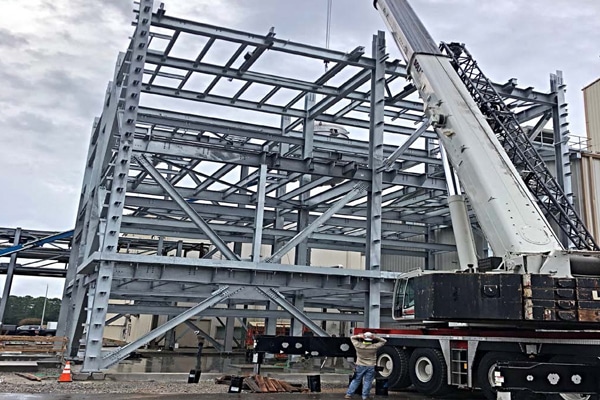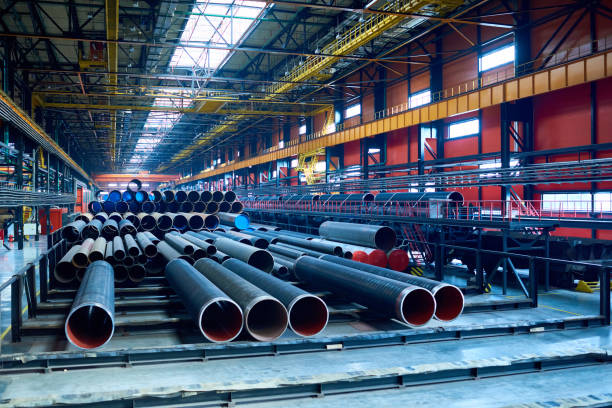Comprehensive Evaluation of Cutting-Edge Techniques in Steel Manufacture Industry
As the steel manufacture industry proceeds to advance, the combination of cutting-edge strategies has become vital for staying competitive and satisfying the needs of modern manufacturing requirements. In this dynamic market where innovation plays a crucial role, understanding the subtleties of these sophisticated techniques is not just an option but a necessity for those looking to forge in advance in the ever-evolving world of steel fabrication.
Laser Cutting Developments
In the world of steel manufacture, laser reducing innovations have transformed the precision and effectiveness of steel shaping procedures. By harnessing the power of focused laser beam of lights, makers can currently achieve unequaled levels of accuracy when puncturing various kinds of steels. This innovation makes it possible for elaborate styles to be carried out with minimal product wastage, making it a cost-efficient option for sectors needing high accuracy parts.
Among the key advantages of laser cutting is its ability to handle a large range of materials, including stainless steel, aluminum, and carbon steel, with simplicity. The procedure creates tidy, burr-free sides, eliminating the need for added ending up actions. In addition, the non-contact nature of laser reducing reduces the risk of material contamination, causing greater high quality final result.
Furthermore, laser cutting equipments can be set to make swift, exact cuts, significantly minimizing manufacturing time contrasted to conventional cutting methods. This rate and precision make laser cutting particularly ideal for automation environments where performance is extremely important. As technology remains to advance, laser cutting is positioned to play a progressively crucial role in the steel construction market.

CNC Machining Innovations
The development of CNC machining innovations has ushered in a brand-new age of accuracy and efficiency in the steel fabrication market. Computer Numerical Control (CNC) makers have revolutionized steel fabrication by supplying unmatched accuracy and repeatability in the manufacturing procedure. steel fixing. One of the essential technologies in CNC machining is the assimilation of advanced software application systems that make it possible for real-time tracking and adjustments, leading to enhanced productivity and quality assurance
Furthermore, the growth of multi-axis CNC devices has enabled for the manufacture of complicated steel elements with elaborate styles that were previously challenging to create. These equipments can perform a wide variety of machining operations, including milling, drilling, turning, and grinding, all with high levels of accuracy.
Moreover, the incorporation of automation and robotics in CNC machining has structured manufacturing procedures, decreased preparations, and minimized the margin of error. This integration of sophisticated innovations not just increases performance however likewise guarantees regular top quality throughout all made steel components. To conclude, CNC machining innovations proceed to drive improvements in the steel fabrication industry, establishing brand-new requirements for precision and productivity.
Automated Welding Technologies
Automated welding modern technologies have actually revolutionized the steel fabrication industry, boosting effectiveness and precision in the welding process. These sophisticated technologies use computer-controlled systems to automate the welding procedure, resulting in higher performance levels and boosted weld high quality. Among the essential benefits of automated welding is the ability to perform complicated welds with constant read review accuracy, minimizing the chance of mistakes and rework.
Robot welding systems are at the center of automated welding technologies, using unrivaled rate and accuracy. These systems can handle a variety of welding tasks, from simple to complex, effortlessly (steel fixing). By utilizing innovative sensing units and software, robotic welders can adapt to variations in product and joint geometry, ensuring an attire and reliable weld
Additionally, automated welding technologies boost workplace safety and security by reducing the direct exposure of human welders to unsafe fumes and extreme warm. As the steel manufacture sector remains to develop, incorporating automated welding innovations will certainly be vital for companies aiming to remain affordable and fulfill the expanding demands for premium bonded items.
Robotics Integration in Fabrication
Using robot systems in manufacture procedures has actually come to be a pivotal strategy for boosting effectiveness and precision in modern manufacturing atmospheres. Robotics integration in steel manufacture offers a myriad of benefits, including enhanced performance, enhanced quality assurance, and boosted safety actions. These advanced robotic systems are furnished with advanced sensing units and programs capacities, allowing them to do complex tasks with a high level of precision and repeatability.
One of the key benefits of robotics assimilation in steel manufacture is the capability to automate repeated tasks, such as product handling, cutting, welding, and setting up procedures. This not only speeds up manufacturing cycles yet additionally lowers the danger of human error, leading to greater general product high quality. Furthermore, robotics can run 24/7, dramatically boosting manufacturing output and conference limited project target dates.

3D Printing in Steel Production
Having actually reinvented the steel fabrication market with robotics assimilation, the burgeoning exploration of 3D printing in steel manufacturing is positioned to more breakthrough the realm of contemporary manufacturing techniques. 3D printing, likewise called additive production, supplies unprecedented layout freedom and complexity, allowing the development of detailed steel frameworks that were formerly unattainable via standard production approaches. By using computer-aided design (CAD) software application, suppliers can specifically regulate the layer-by-layer deposition of steel product, causing get rid of boosted performances and geometries.
Among the key advantages of 3D printing in steel manufacturing is its capability to reduce material waste substantially. Unlike subtractive production procedures where excess product is cut away, 3D printing only uses the necessary amount of steel needed for the last part. This effectiveness not just brings about set you back savings but likewise lines up with sustainable production techniques by lessening environmental impact.
In addition, 3D printing makes it possible for fast prototyping and customization, enabling the manufacturing of little batches of complex steel components with short preparations. As visit this web-site the modern technology remains to mature and come to be a lot more easily accessible, its assimilation into mainstream steel fabrication processes is expected to drive innovation and efficiency throughout the market.
Conclusion
Finally, the steel manufacture sector has seen considerable developments in strategies such as laser cutting, CNC machining, automated welding, robotics assimilation, and 3D printing. These cutting-edge innovations have actually reinvented the way steel items are manufactured, resulting in raised effectiveness, accuracy, and cost-effectiveness. Proceeded financial investment in these cutting-edge strategies is vital for the industry to stay affordable and meet the demands of contemporary manufacturing procedures.
As the steel construction sector continues to advance, the integration of advanced strategies has actually ended up being crucial for remaining competitive and meeting the needs of modern manufacturing requirements.One of the key advantages Click This Link of laser cutting is its capacity to take care of a large array of products, including stainless steel, light weight aluminum, and carbon steel, with convenience.Automated welding modern technologies have actually revolutionized the steel manufacture market, improving efficiency and precision in the welding process.Having actually changed the steel construction sector via robotics assimilation, the expanding exploration of 3D printing in steel production is poised to further advance the world of modern production methods.In verdict, the steel fabrication industry has seen considerable developments in strategies such as laser cutting, CNC machining, automated welding, robotics combination, and 3D printing.